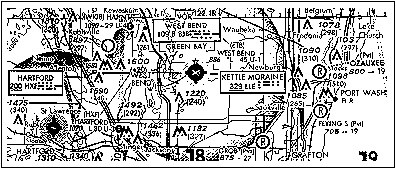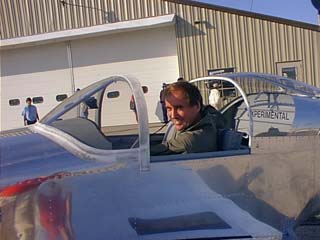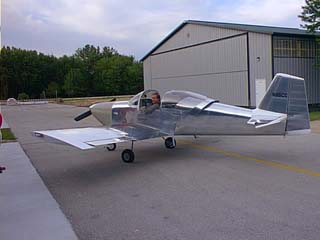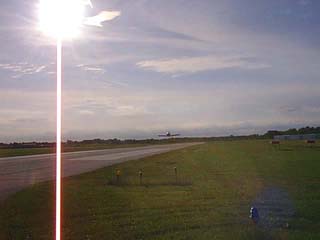First Flight
After nearly three years of building, my RV-6A took to the air
yesterday. It was at a Chapter 1158 meeting, home-builder's night, that
I first decided to build an airplane. Since then, I've received a lot
of help, support & inspiration from this Chapter & its members. Thank you all.
Here's my first flight report.
Chris Good, Saturday, 3rd June 2000
The day started out with an hour in a Piper Arrow with an instructor.
While I had been flying a rented Cessna 172 fairly frequently, I
hadn't flown the Arrow for more than a year, & wanted to get a check
out in an unfamiliar aircraft in preparation for the 6A. Also the
Arrow has a much higher power off sink rate than the 172. We did some
slow flight, stalls & a couple of landings, as well as emergency
procedures.
Next I flew a 172 to the EAA Chapter 18 picnic 45 nm away at Burlington.
Met with my flight advisor, Jerry Thorpe. Several of the chapter
members are building or flying RVs. Marty Pavlovich has helped me a
lot through this whole building adventure. He brought his 6A to the
picnic & let me fly left seat for about an hour, going through some
more slow flight & a couple of landings. In the last two years, I had
three sessions with Mike Seager in Van's 6A, but the last minute
polish up with Marty helped a lot.
The plan had been to do the first flight early Sunday morning, but the
weather was perfect on Saturday, with rain forecast to move in on
Sunday. I decided that we should go for it Saturday evening. We got
back to West Bend at about 3:30 & picked up the Airworthiness
Certificate that the DAR, Tom Willis, had left there for me - the
inspection was completed the day before. I needed about an hour to
screw down floorboards & inspection plates removed for the DAR.
The engine started right away & I taxied to the pumps. We added fuel
to give me about 16 Gals. left & 12 Gals. right. The plan was to use
left tank only for a first flight of an hour or less. Kyle, my second
flight advisor, thought the tires looked a little soft. We checked
& found them right at the 30 psi (mains) & 25 psi (nose) that I had set,
but we decided to add 5 psi to each & they did look better that way.
Taxiing felt fine, with no tendency to pull left or right.
After the usual thorough engine run-up, I taxied onto runway 13, 4500
feet by 75 feet. The wind was about 5 kts at 110, so nothing to worry
about. Brought power up smoothly, getting 2200 rpm with the Sensenich
prop. I had no problems keeping it on the center line, with plenty of
right rudder countering the 180 HP from the O-360. I took the weight
off the nose wheel early, & lifted off in well less than 1000 feet.
It felt very stable & controllable, so I climbed straight out, intending
to climb to 4000 feet over the airport. At less than 1000 feet AGL the
Big Red Light on my panel started flashing at me! I installed the
Grand Rapids EIS-4000 engine monitor, & it was telling me that CHT on
cylinder 3 had exceeded the 450 deg limit that I had set. In fact it
was up to 480 & climbing. I leveled off to improve cooling, but it
continued to climb, so I called my ground crew & told them I was coming
round to land. As I continued onto downwind, the CHT stabilized. Kyle
told me that she had seen CHT at 500 right after her engine overhaul.
At this point CHT was dropping so we decided not to land, but to
continue
the flight test as planned. Studying the engine log afterwards, I could
see that CHT3 was at 398 at the start of the take-off roll, & rose to
450 in 30 seconds. It peaked at 488 deg 60 secs later.
The rest of the flight was pretty uneventful. The left wing was
slightly heavy, but I had more fuel & me on that side, so I'm not going
to take any corrective action yet. The imbalance was not enough to
prevent controllable rudder turns without aileron input. Elevator
control was fine with good trim control via the Matronics governor.
Slow flight at about 60 kts was stable. Stall in the landing
configuration was at about 45 kts IAS with a left wing drop, but easily
recovered.
It was time to land. I kept the pattern close to the runway, & ended up
high on final. I didn't want to slip it in, but full flaps & 70 kts
gave me plenty of sink for a steep approach, although my ground crew
found the view slightly alarming! Added a little power and made a nice
flare. Power off, squeak squeak, hold the nose wheel off, track
straight, brakes, turn off at the intersection. Wow! I'd been making
mediocre landings all day, but this last one couldn't have been better!
Many thanks to the entire ground crew for their patience & support.
Knowing they were there for me gave me the confidence I needed to make
this first flight successful.
I'll report performance numbers after some more test flights. I can't
wait to get it back in the air, so it won't be long. Pictures & video
should be on my website in the next couple of days.
RV-6A(QB) N86CG, O-360-A1A new from Van's with Sensenich metal fixed pitch prop,
2100 hours build time, starting September 97. Chris Good, www.slinger.net/rv-6a
Fellow Chapter members,
N86CG is the best built Amateur-built aircraft that I have had the pleasure
to inspect to date. Chris and his "team" are worthy of a trophy for not
only outstanding craftsmanship but for the immaculate attention to detail
exhibited from the builder's log to the preparation for the first flight.
I hope you all get a chance to congratulate Chris, Sue and their son, Tom, on
a job well done indeed!
From the Flying W ranch in Augusta, Kansas
Warm regards,
Tom Willis
FAA DAR and Chapter 1158 Member

 From the Editor
From the Editor
by Dan Staehler, Newsletter Editor
I will be resigning from the newsletter editor position after the November/December 2000 issue. That will make 17 issues, or a little over two-and-a-half years. If you have interest in the position as newsletter editor please notify me or one of the other board members.

Classifieds
Chapter member Greg Reiff is seeking a partner for his 1966 Mooney M20C, due to impending completion of a Pulsar kitplane. The aircraft is hangared at West Bend. Greg is looking for a partner who will fly 100-200 hours per year.. Aircraft specifications are: TTAF 2850, SMOH 1100. 3-blade McCauley prop 50 SNEW. New glass, newer interior, P&I 8.5/8. Recent maintenence includes prop replacement, carb & exhaust overhaul, one cylinder replacement. New TKM MX170B navcom installed 1998, remaining avionics are King: KX175B navcom, KR86 ADF, KT78 transponder, KMA20 audio panel, KN65 DME. Other equipment includes Sigtronics 4 place intercom, Davtron 903 Digital VOR and Davtron M655 digital voltage/temp/pressure altitude/density altitude.
Interested members can contact Greg at 692-9827 (home) or 354-6600 ext 3380 (office).

Membership Report
by Biju Daniel, Membership Chairman
We have two new members, David Miller and Stephen Brogli.
.
This brings us to a total of 61 members who are current in their membership.
Welcome aboard!


Board Meeting Minutes
by Russ Kaye, Secretary
MAY 2000
Present: Keith Brue, President; Ron Champeny, Vice President; Russ Kaye, Secretary; Don Shane, Treasurer>> (Present after ground school)>>Glen Brandt, Jim Dricken, Randy Finco, Howard Kaney, Dan Staehler, Paul Lupton (Arrived mid-meeting for Aero-Camp report)>> Jim Dricken moved and Glen Brandt seconded to accept the amended April board meeting minutes and the 22 April special board meeting minutes. Motion approved unanimously.>> Keith Brue motioned seconded by Russ Kaye to appoint Randy Finco to the Board of Directors. Motion passed unanimously.>> Keith Brue motioned seconded by Russ Kaye to appoint Paul Lupton to the Board of Directors. Motion passed seven to one.>> Treasures Report: Glen Brandt reported for Don Shane that Visa and Master Card still owe us some money. Keith and Don will follow up.>> Membership Committee Report: Howard Kaney reports 74 current members. 58 paid year 2000 dues, 16 still unpaid. Letters will be sent to those still unpaid.>> Facility Committee Report: Ron Champeny reported he anticipates the carpet will be installed soon. The cabinet installation should begin this week. He has the door handle hardware. He will start the staining soon.
Jim Dricken reports the west entry doors and windows will be coming soon and the concrete work will start next week.>> Program Committee Report: Randy Finco reported that Tom Anderson would be the speaker at the May 17th Chapter meeting. He will have his Kitfox Aircraft that he flew to Alaska. Next month will be an R/C Aircraft presentation.>> Howard Kaney suggested using a checklist for Chapter meetings.>> Raffle:
Jim Dricken proposed beginning the raffle as soon as possible seconded by Glen Brandt. Raffle prizes amended to: Grand Prize, 1@$10,000.00 1st Prizes, 2@$1,000.00 2nd Prizes, 10@$100.00 Proposal passed unanimously.
By-Laws:
Howard Kaney made a motion seconded by Jim Dricken not to adopt EAA's Chapter Dissolution clause but to adopt the following as our Dissolution Clause:
DISSOLUTION CLAUSE: Upon the dissolution of the corporation, the Board of Trustees shall, after paying or making provisions for the payment of all the liabilities of the corporation, dispose of all the assets of the corporation exclusively for the purposes of the corporation in such manner, or to such organization or organizations organized and operated exclusively for charitable, educational, religious, or scientific purposes as shall at the time qualify as an exempt organization or organizations under Section 5Ol © (3) of the Internal Revenue Code of 1986 (or the corresponding provision of any future United States Internal Revenue Law), as the Board of Trustees shall determine. Any such assets not so disposed of shall be disposed by the Court of Common Pleas of the County in which the principal office of the corporation is then located, exclusively for such purposes or to such organization or organizations, as said court shall determine, which are organized and operated exclusively for such purposes.
The motion passed unanimously.
B-17 Event:
Jim Pieper volunteered to be the other chairman.
Lease:
There has been no change in the status of the lease.
Chamber of Commerce:
Our facility will host the 23 AUG meeting.
Air Camp:
Paul Lupton reported the posters are in place. The signs have been made. The Class 1 event paperwork has been filed with Oshkosh. He would like to have the roster filled by 1 JUNE.
There was a lengthy discussion regarding facility use.

Chapter Calendar
Chapter Fly-Out: 1st Sunday of each month, 8:00 am, West Bend Air (Mark Hanrahan, 243-3666)
Chapter Meeting: 3rd Wednesday of each month, 7:00 pm EAA Chapter 1158 hangar
310 Aerial Drive West Bend, Wisconsin Phone: (262)338-8411
7/14, 15, 16 Fri. Sat. Sun. B-17 Aluminum Overcast Visit and B-17 Rides/ ( Open House Canceled )
7/15 Sat. Spot Landing Contest and Cookout
7/19 Chapter Meeting
7/28 or 29 Sat. or Sun. Chapter trip to Oshkosh
8/16 Wed. 7pm Aircraft Maintenance/Safety Program/ Preflight Contest

| Schedule of Chapter Programs for AirVenture 2000 |
|
Wednesday July 26th |
- 10:00am to 11:00am (Chapter House) - Chapter Roundtable Discussions -- (Deck-1) “Chapter Leadership Transition” & (Deck-2) “Attracting and
Retaining New Chapter Members”
|
|
|
|
Thursday July 27th |
- 10:00am to 11:00am (Chapter House) - Chapter Roundtable Discussions - (Deck-1) “Chapter Flying Clubs” & (Deck-2) “Introduction to EAA
Chapters” (How to form a Chapter, How to Find a Chapter etc…)
|
|
|
|
Friday July 28th |
- 8:00am to 10:00am (Vette Theater in the AirVenture Museum) - Chapter Newsletter Editor’s Workshop --, Come Meet the Editors of Sport
Aviation, Scott Spangler and Mike DiFrisco (both former EAA Chapter Newsletter Editors).
|
|
|
|
|
|
|
|
Saturday July 29th |
- 8:00am to 10:30am (EAA Nature Center) - Chapter Leaders Breakfast --, Join us for a morning of interacting with other Chapter Leaders from all
over the world, meet EAA Staff Members, and enjoy a great Breakfast (FREE)! Please RSVP by sending your name, Chapter Number, and EAA
Number to 800-236-4800, ext. 4876, fax at (920) 426-6560, or e-mail to
chapters@eaa.org.
|
|
|
|
Sunday July 30th |
- 10:00am to 11:00am (Chapter House) - Chapter Roundtable Discussions - (Deck-1) “How to Become a Good Chapter Leader!” & (Deck-2)
“Chapter Clubhouses and Hangars”
|
|
|
|
Monday July 31st |
- 10:00am to 11:00am (Chapter House) - Chapter Roundtable Discussions - (Deck-1) “Chapter Flying Clubs” & (Deck-2) “Introduction to EAA
Chapters” (How to form a Chapter, How to Find a Chapter etc…)
|
|
|

Cross-Country Questions
These questions are drawn from the knowledge test question banks for the private, commercial, and flight instructor certificates and the instrument rating. The applicants for these certificates and ratings must possess the knowledge to answer these questions, and so must flight instructors. How current is your knowledge? Have fun!
1. The definition of nighttime is
A. The time between the end of evening civil twilight and the beginning of morning civil twilight.
B. Sunset to sunrise
C. 1 hour after sunset to 1 hour before sunrise.
2. What document(s) must be in your personal possession or readily accessible in the aircraft while operating as pilot in command of an aircraft?
A. An appropriate pilot certificate and an appropriate current medical certificate if required.
B. Certificates showing accomplishment of a checkout in the aircraft and a current biennial flight review.
C. A pilot certificate with an endorsement showing accomplishment of an annual flight review and a pilot logbook showing recency of experience
3. The width of a Federal Airway from either side of the centerline is
A. 6 nautical miles B. 4 nautical miles C. 8 nautical miles
4. What is the specific fuel requirement for flight under VFR during daylight hours in an airplane?
A. Enough to fly to the first point of intended landing and to fly after that for 45 minutes at normal cruising speed.
B. Enough to fly to the first point of intended landing and to fly after that for 30 minutes at normal cruising speed.
C. Enough to complete the flight at normal cruising speed with adverse wind conditions.
5. A Third-Class Medical Certificate is issued to a 36-year-old pilot on August 10, this year. To exercise the privileges of a Private Pilot Certificate, the medical certificate will be valid until midnight on
A. August 31, 3 years later
B. August 31, 2 years later
C. August 10, 2 years later
6. Normal VFR operations in Class D airspace with an operating control tower require the ceiling and visiblility to be at least
A. 1,000 feet and 3 miles
B. 2,500 feet and 3 miles
C. 1,000 feet and 1 mile
7. Preflight action, as required for all flights away from the vicinity of an airport, shall include
A. A study of arrival procedures at airports/heliports of intended use
B. An alternate course of action if the flight cannot be completed as planned
C. The designation of an alternate airport
8. Except when necessary for takeoff or landing, what is the minimum safe altitude required for a pilot to operate an aircraft over congested areas?
A. An altitude of 1,000 feet above any person, vessel, vehicle, or structure
B. An altitude of 500 feet above the highest obstacle within a horizontal radius of 1,000 feet of the aircraft
C. An altitude of 1,000 feet above the highest obstacle within a horizontal radius of 2,000 feet of the aircraft
9. A blue segmented circle on a Sectional Chart depicts which class airspace?
A. Class B
B. Class C
C. Class D
10. An aircraft is loaded 110 pounds over maximum certificated gross weight. If fuel (gasoline) is drained to bring the aircraft weight within limits, how much fuel should be drained
A. 18.4 gallons
B. 15.7 gallons
C. 16.2 gallons

Officers, Teams, Committees

This and all Kettle Moraine EAA Chapter 1158 newsletters are
provided for your enjoyment only. No claim is made and no
liability is assumed, expressed or implied as to the accuracy
or safety implications of any material presented. Viewpoints
of the writers are not necessarily those of this or any EAA
Chapter or of the Experimental Aircraft Association (EAA).
Use of any of the material presented, whether by applying,
copying or quoting, is done solely at the risk of the user.








 Mailbag
Mailbag



 From the Editor
From the Editor











 Chapter Newsletter Index
Chapter Newsletter Index




 Kettle Moraine EAA Chapter 1158 Webmaster
Kettle Moraine EAA Chapter 1158 Webmaster